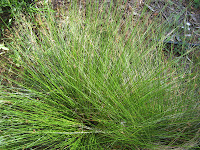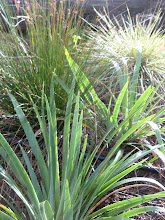
The starting of fires was considered a spiritual act capable of
serious consequences. Prayer formulas and other beliefs were associated with
burning. Once lit, fires were often spoken to as to how they should behave
and conduct themselves to achieve desired resource objectives of the igniter (p.
99).
Patches and fields were located along trails that typically ran adjacent to rivers
and streams, the coast, and along ridgelines, directly connecting communities, peaks,
campgrounds, waterfalls, springs, and other favored subsistence and ceremonial
locations. Fires were also used to clear and maintain trails; rejuvenate berry patches,
wild pea fields, root and bulb fields, and orchards; for hunting; for weed control; and
to cure large fields of tarweed (Madia elegans Lindley) and grass seeds ("Indian
oats"). Daily and seasonal trail clearing activities, combined with seasonal and
occasional brush clearing, hunting, seed curing, and sprout-inducing burns were nearly year-around activities.
meadows traditionally maintained by fire have been lost. One example is at Patrick's Point (between Trinidad and Big Lagoon). When Europeans took over the area, they kept the meadows open with fire and with their cattle. When it was made into a State Park and the ranchers were removed, the spruce and shrubs began moving in. Today I know that there is at least one meadow area that the state burns occasionally to encourage the native prairie
plants.
Indians used fire to clear brush and debris from riparian areas and marshes to
stimulate new grass, plant growth, and shrub and tree sprouts. Target
species were cottonwoods (Populus balsamifera spp. trichocarpa Torrey &
A. Gray), willows (Salix spp.), tules (Scirpus acutus Bigelow var. occidentalis
(S.Watson) Beetle), cattails (Typha latifolia L.), sedges (Carex spp.), and
grasses.
Trails were about two feet wide, worn into bare mineral soil, and served as fire
lines in many cases for low intensity surface fires.










 After they were sauteed with a bit of butter, they shrunk down quite a bit, into these black slug-like things. But they tasted good. Like an over-cooked button mushroom, but with a deeper flavor.
After they were sauteed with a bit of butter, they shrunk down quite a bit, into these black slug-like things. But they tasted good. Like an over-cooked button mushroom, but with a deeper flavor. No. It's pepper.
No. It's pepper. 
 The leaves of hazel are downy soft, especially in early spring, are more finely toothed than alder, and more ovular. I also really like their arrangement on the skinny flexible stems. Hazels also have very attractive catkins in spring. I think I've seen some female flowers too (they may have just been buds), but I haven't seen any nuts. Never.
The leaves of hazel are downy soft, especially in early spring, are more finely toothed than alder, and more ovular. I also really like their arrangement on the skinny flexible stems. Hazels also have very attractive catkins in spring. I think I've seen some female flowers too (they may have just been buds), but I haven't seen any nuts. Never.





















